Do you have a question about the Toyota Corolla 2002 and is the answer not in the manual?
Covers the operation and function of keys and vehicle doors.
Covers adjustments and safety features for seats, seat belts, steering, and mirrors.
Details the layout and components of the instrument panel.
General seating precautions and seat adjustment guidelines.
How to operate headlights, high/low beams, and turn signals.
Explains the different ignition switch positions and steering lock operation.
Identifies and explains the main controls of the air conditioning system.
Explains the layout and function of the instrument cluster gauges.
Safety measures related to front seats, especially with SRS side airbags.
Details the operation of the automatic transmission, including the shift lock system.
Explains the meaning of various warning and indicator lights.
Instructions on operating power windows and child protection features.
Detailed steps for adjusting seat position and seatback angle.
Explains various indicators and buzzers for vehicle maintenance reminders.
What the brake system warning light indicates and actions to take.
General seat belt precautions for all occupants.
Specific safety advice for using seat belts, including for children and pregnant women.
How to use and adjust front and rear seat belts correctly.
How to adjust the shoulder anchor position for proper seat belt fit.
Operation of the 4-speed automatic transmission, including shift lock.
Proper positioning of lap and shoulder belts for safety.
Warns about critically low engine oil pressure.
Indicates issues with the anti-lock brake system.
Explanation of how front seat belt pretensioners work during a frontal impact.
Information on the function and safety precautions for front airbags.
Explains when the front airbags deploy and under what conditions they may not.
Details how airbags inflate, their components, and potential effects of front airbags.
Critical safety warnings regarding airbag deployment and occupant positioning.
Detailed instructions for operating the manual transmission.
Warnings about placing children in front seats with airbags.
Precautions for children regarding airbags and seating positions.
How to operate the cruise control system for maintaining speed.
Warnings against modifying or removing airbag system components.
Explains the function and safety precautions for side airbags.
Details how side airbags operate and when they may not activate.
Information on airbag inflation, components, and potential effects of side airbags.
Critical safety warnings for occupants regarding side airbags.
Warnings about attaching objects or modifying seats that could affect side airbags.
General information and precautions for using child restraint systems.
Essential safety advice for installing and using child restraint systems.
Guidelines for using child restraint systems based on child age and size.
Details the components and operation of the integrated child restraint system.
Specific instructions and cautions for using the built-in child restraint system.
Step-by-step guide for installing the built-in child restraint system.
How to adjust shoulder belts and install the removable pad.
Instructions for seating the child and fastening the seat belts.
Specific warnings for installing rear-facing infant seats, especially concerning airbags.
Safety warnings for convertible seat installation, particularly with airbags and side doors.
Information on recommended fuel types and octane ratings.
Safety precautions related to engine exhaust fumes.
Overview of the brake system, including tandem master cylinder and booster.
How the ABS system works, pedal operation, and limitations.
Warnings against mixing tire types or using incorrect tire sizes.
Procedures for starting the engine, including normal and flooded engine starts.
Essential tips for driving safely in winter conditions.
Guidelines and precautions for towing a trailer, including weight limits.
Troubleshooting steps if the vehicle fails to start.
What to do if the engine stalls while the vehicle is in motion.
Procedures to follow if the vehicle's engine overheats.
Steps for changing a flat tire, including jacking and spare tire usage.
Instructions and methods for towing a vehicle.
Basic checks to perform if the vehicle won't start.
How to start the engine if it has become flooded.
Step-by-step guide for jump-starting a vehicle's battery.
What to do if the engine stalls during operation.
Procedures to follow if the vehicle's engine overheats.
Steps for changing a flat tire, including jacking and spare tire usage.
Procedure for removing the flat tire and installing the spare.
Procedures for emergency towing when professional service is unavailable.
Explains the importance of maintenance for vehicle longevity and performance.
Information on the recommended maintenance schedule.
Clues that indicate when service or repair may be needed for the vehicle.
How to check the engine oil level and select the correct oil.
Precautions and steps for checking the battery's condition.
How to check and add engine coolant, and select the correct type.
Safety warnings and emergency measures related to the battery.
Essential safety precautions before performing DIY maintenance.
How to check and add brake fluid, with safety precautions.
Correctly positioning the jack for safe vehicle lifting.
Safety guidelines and procedures for recharging the vehicle battery.
How to check tire pressure and the importance of proper inflation.
How to check for blown fuses and replace them correctly.
How to check tire condition, tread wear, and replace tires.
Instructions and safety precautions for replacing various light bulbs.
How to replace headlight bulbs, including aiming adjustments.
Step-by-step guide for replacing the left-hand headlight bulb.
Detailed steps for removing and installing headlight bulbs.
Engine specifications, including model, type, bore, stroke, and displacement.
Fuel type, octane rating, and fuel tank capacity.
Technical specifications for engine, lubrication, cooling, battery, and brakes.
Tire size, pressure, wheel size, and nut torque specifications.
Lists fuse types, amperage ratings, and their circuit functions.
Lists fuses located in the engine compartment and their functions.
Lists fuses located in the instrument panel and their functions.
Covers the operation and function of keys and vehicle doors.
Covers adjustments and safety features for seats, seat belts, steering, and mirrors.
Details the layout and components of the instrument panel.
General seating precautions and seat adjustment guidelines.
How to operate headlights, high/low beams, and turn signals.
Explains the different ignition switch positions and steering lock operation.
Identifies and explains the main controls of the air conditioning system.
Explains the layout and function of the instrument cluster gauges.
Safety measures related to front seats, especially with SRS side airbags.
Details the operation of the automatic transmission, including the shift lock system.
Explains the meaning of various warning and indicator lights.
Instructions on operating power windows and child protection features.
Detailed steps for adjusting seat position and seatback angle.
Explains various indicators and buzzers for vehicle maintenance reminders.
What the brake system warning light indicates and actions to take.
General seat belt precautions for all occupants.
Specific safety advice for using seat belts, including for children and pregnant women.
How to use and adjust front and rear seat belts correctly.
How to adjust the shoulder anchor position for proper seat belt fit.
Operation of the 4-speed automatic transmission, including shift lock.
Proper positioning of lap and shoulder belts for safety.
Warns about critically low engine oil pressure.
Indicates issues with the anti-lock brake system.
Explanation of how front seat belt pretensioners work during a frontal impact.
Information on the function and safety precautions for front airbags.
Explains when the front airbags deploy and under what conditions they may not.
Details how airbags inflate, their components, and potential effects of front airbags.
Critical safety warnings regarding airbag deployment and occupant positioning.
Detailed instructions for operating the manual transmission.
Warnings about placing children in front seats with airbags.
Precautions for children regarding airbags and seating positions.
How to operate the cruise control system for maintaining speed.
Warnings against modifying or removing airbag system components.
Explains the function and safety precautions for side airbags.
Details how side airbags operate and when they may not activate.
Information on airbag inflation, components, and potential effects of side airbags.
Critical safety warnings for occupants regarding side airbags.
Warnings about attaching objects or modifying seats that could affect side airbags.
General information and precautions for using child restraint systems.
Essential safety advice for installing and using child restraint systems.
Guidelines for using child restraint systems based on child age and size.
Details the components and operation of the integrated child restraint system.
Specific instructions and cautions for using the built-in child restraint system.
Step-by-step guide for installing the built-in child restraint system.
How to adjust shoulder belts and install the removable pad.
Instructions for seating the child and fastening the seat belts.
Specific warnings for installing rear-facing infant seats, especially concerning airbags.
Safety warnings for convertible seat installation, particularly with airbags and side doors.
Information on recommended fuel types and octane ratings.
Safety precautions related to engine exhaust fumes.
Overview of the brake system, including tandem master cylinder and booster.
How the ABS system works, pedal operation, and limitations.
Warnings against mixing tire types or using incorrect tire sizes.
Procedures for starting the engine, including normal and flooded engine starts.
Essential tips for driving safely in winter conditions.
Guidelines and precautions for towing a trailer, including weight limits.
Troubleshooting steps if the vehicle fails to start.
What to do if the engine stalls while the vehicle is in motion.
Procedures to follow if the vehicle's engine overheats.
Steps for changing a flat tire, including jacking and spare tire usage.
Instructions and methods for towing a vehicle.
Basic checks to perform if the vehicle won't start.
How to start the engine if it has become flooded.
Step-by-step guide for jump-starting a vehicle's battery.
What to do if the engine stalls during operation.
Procedures to follow if the vehicle's engine overheats.
Steps for changing a flat tire, including jacking and spare tire usage.
Procedure for removing the flat tire and installing the spare.
Procedures for emergency towing when professional service is unavailable.
Explains the importance of maintenance for vehicle longevity and performance.
Information on the recommended maintenance schedule.
Clues that indicate when service or repair may be needed for the vehicle.
How to check the engine oil level and select the correct oil.
Precautions and steps for checking the battery's condition.
How to check and add engine coolant, and select the correct type.
Safety warnings and emergency measures related to the battery.
Essential safety precautions before performing DIY maintenance.
How to check and add brake fluid, with safety precautions.
Correctly positioning the jack for safe vehicle lifting.
Safety guidelines and procedures for recharging the vehicle battery.
How to check tire pressure and the importance of proper inflation.
How to check for blown fuses and replace them correctly.
How to check tire condition, tread wear, and replace tires.
Instructions and safety precautions for replacing various light bulbs.
How to replace headlight bulbs, including aiming adjustments.
Step-by-step guide for replacing the left-hand headlight bulb.
Detailed steps for removing and installing headlight bulbs.
Engine specifications, including model, type, bore, stroke, and displacement.
Fuel type, octane rating, and fuel tank capacity.
Technical specifications for engine, lubrication, cooling, battery, and brakes.
Tire size, pressure, wheel size, and nut torque specifications.
Lists fuse types, amperage ratings, and their circuit functions.
Lists fuses located in the engine compartment and their functions.
Lists fuses located in the instrument panel and their functions.
| Brand | Toyota |
|---|---|
| Model | Corolla 2002 |
| Category | Automobile |
| Language | English |


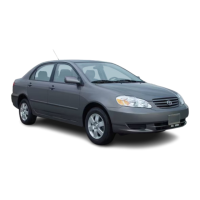
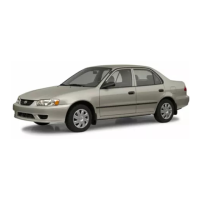
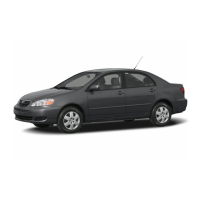
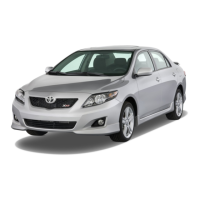
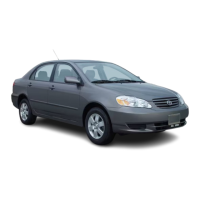

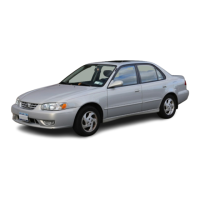
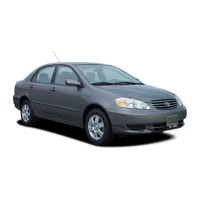
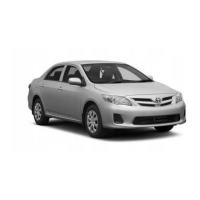
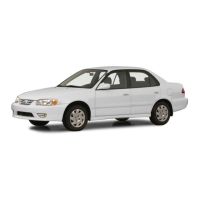
